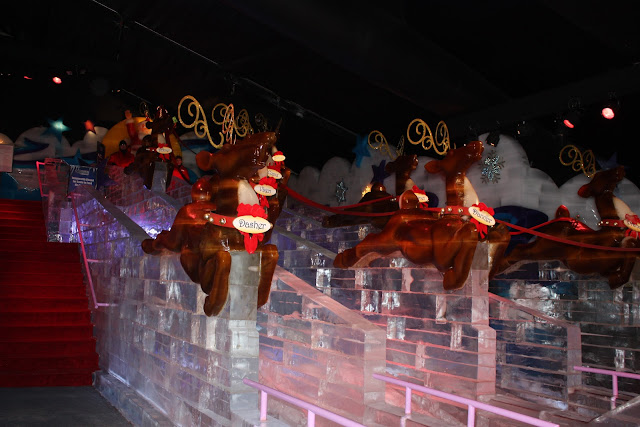 |
 |
| From the Jungle of Gaylord's Everglades to the Artic "ICE" |
It was an early somewhat crisp Sunday morning -- 60 degrees outside when we embarked with some trepidation into the frozen wilderness of "ICE" at 9 degrees -- remember I am a Floridian, anything under 50 is freezing. The Gaylord Palms Hotel is a somewhat daunting place to begin with -- a theme park inside a hotel with all kinds of funky Florida themes that take you through the swamps of the Everglades to Key West, to the walled Spanish look of St. Augustine. But even the dragon pool can't come close to the main attraction here come every November --- "ICE."
Once we had bought our tickets, we were escorted into a room where all sizes of very padded winter coats were provided. (We had come somewhat prepared for this -- and didn't wear sandals for instance and wore long pants.) But as we were to soon find out, we would need those ugly winter parkas.
The exhibition itself is about 18,000 square-feet of frosty characters and settings, that are carved each year by a team of artisans from Harbin, China. Harbin is world-famous for its annual Ice and Snow Festival where more than 2,000 sculptors annually care a 100-acre walk through an ice park. Ice Lantern Festivals can be traced back as far as the late Ming and early Qing dynasties of Imperial China where 500 years ago hunters created ice lanterns to help guide themselves home.
We walked through a huge ice tunnel into a vast frozen world. And I have to admit I was truly awed by the intricate carvings of bears, sheep, angels, reindeer and more. Most impressive were the huge ice-carved manger and carousel. And, of course, I had to try the ice slide -- hey I had the parka to protect me.
This year's "ICE" at the Gaylord Palms opens tomorrow. The Theme for 2010 is "Twas the Night Before Christmas" And if you decide to go, even if you don't stay at the Gaylord, check out the hotel, it is unique! And be sure to bring hats, gloves and dress warm--it's cold even in Florida. For more information, or to purchase your tickets by phone, call (407) 586-4423.














